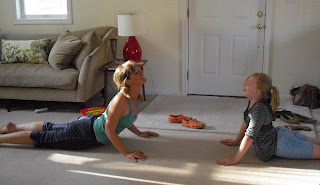We are always asking my grandmother for her recipes. And she always says, "Oh, that's just from the Mennonite Community Cookbook." (This is a giant old tome that is owned by all of us and, I think it is safe to say, all the other Mennonite women in South Eastern Ontario as well). Our next question is always, "Well then why doesn't mine come out anything like yours?!"
One day I gave up. I wanted to be able to make my favorite snack, molasses cookies, just like she did, and following the directions in the MCC cookbook was just not cutting it. So I made them in her kitchen, from the recipe in the book, and had her watch my every move. For the first few minutes she insisted that it was a useless exercise and I had the recipe right there! But then it started, "Oh, don't put in so much flour! They'll be too tough." And then, "Never put as much baking soda as they say - half is enough." Okay. "Add a little more cinnamon, your grandfather liked that. Oh, but I don't add the ginger - I don't like ginger so much." And finally, "Put the oven a little hotter than they say, and bake them for less time so they'll be chewier."
That was the day I realized the necessity of cooking together as much as possible. Of course, this used to be common place. This was the way recipes stayed alive--learn them from your grandmother and teach them to your grandchildren. It is harder these days though, and takes a little special effort, especially if you live far away from eachother, as is the case in my family. After the cookie experience in my teens, I put in the effort, taking a special trip to Grandma's house in the late summer to help her with canning, preserving, and jam making. And although my nieces live quite a long ways away from me as well, on my recent visit with my sister, I made sure to spend a day in the kitchen with them. The best conversations take place there, and the funnest experiments. My youngest niece and I devised a fun experiment to understand how yeast works. She also took these pictures of her older sister and I on our pizza and s'more day...





Meghan teaches a little yoga while the pizza bakes...





























